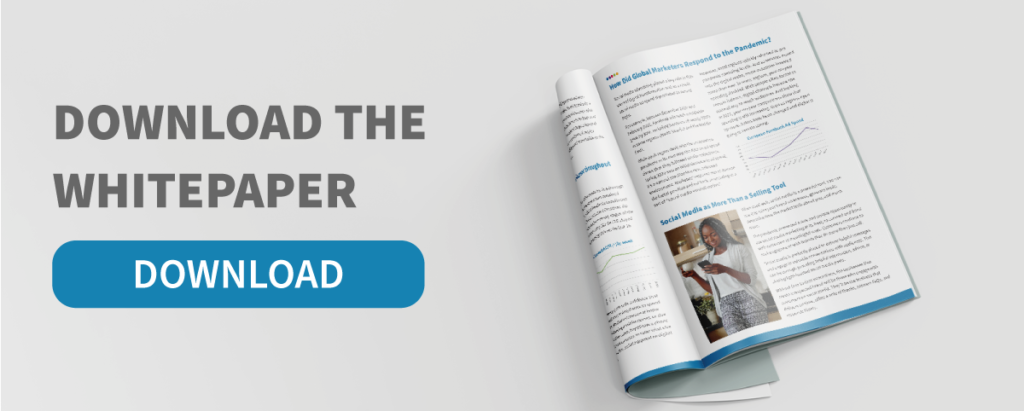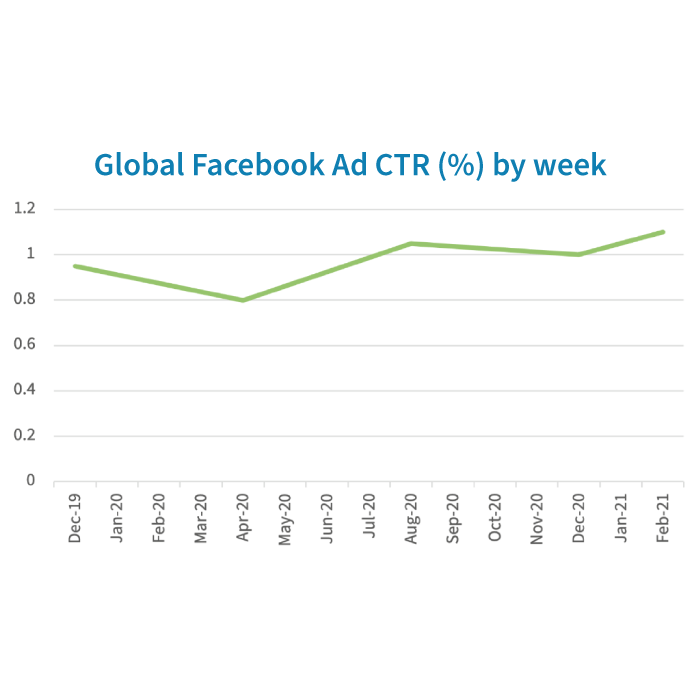
There’s no denying that the past year has tested even the most seasoned marketers. Those able to pivot into a fully digital strategy have thrived, while businesses who were unable to adapt have faced more hurdles than ever before. Customer expectations and changes in demand are here to stay and, now more than ever, it’s key for businesses and marketing teams to remain flexible in the new digital landscape.
How Did Customers Engage with Businesses throughout the Pandemic?
According to data from Vamp Brands1, global mobile usage increased an average of one hour per day during the pandemic. On top of this, two-thirds of consumers say they’re likely to continue using social media to the same extent once restrictions are lifted.
Data from digital analysts Social Bakers2 also presents a wealth of fascinating stats that show the true digital changes in landscape.
Overall, monthly Facebook ad account reach from 2019 to 2020 increased by +19%. There are a number of factors that could have caused this uptrend.
One possibility is that increased spending by businesses on Facebook drove more advertised content on users’ news feeds. Alternatively, this could signal a change in consumer behaviour; maybe consumers were more likely to engage with advertising, making it easier for the Facebook algorithm to find users to surface advertising. Whatever the specific reasons, this trend shows both the resilience of digital advertising through the pandemic period and also its effectiveness.
According to Socialbakers data, the click-through rate (CTR) for all brand ad accounts remained remarkably consistent throughout a tumultuous 2020. Other than the annual post-Christmas dip and a noticeable decline in the early stages of the pandemic in March to May 2020, the CTR stayed quite steady, averaging 1.01% over the last 16 months.

That consistency speaks to the confidence that marketers feel when looking at where to spend their budget. Whether customers are at home for social distancing or isolation reasons, or due to a lack of other outlets, they still have a phone and an internet connection. No matter what else is going on, they can find engagement on digital channels.
How Did Global Marketers Respond to the Pandemic?
Social media advertising played a key role in this wave of digital transformation and as a result social media ad spend skyrocketed to record highs.
For example, between December 2019 and February 2021, Facebook ads reach worldwide grew by 30%, including increases of nearly 100% in some regions (North America and the Middle East).
While each region dealt with the coronavirus pandemic in its own way, the data on ad spend shows that they followed similar trajectories. Spring 2020 saw an initial decrease in ad spend; it’s a natural reaction to a new, unknown environment. Marketers’ response was to assume the foetal position and cut back on spending in a sort of “social media survival instinct”.
However, most regions quickly returned to pre-pandemic spending levels. And as services moved into the digital realm, some industries invested more than ever. In many regions, year-on-year spending doubled. With people often forced to remain indoors, digital channels became the optimal way to reach audiences. And looking at 2021, year-on-year comparisons show that spending is still increasing. Even as regions open up more, habits have been changed and digital is going to remain strong.

Social Media as More Than a Selling Tool
When used well, social media is a powerful tool. You can use it to raise your brand awareness, generate leads, determine how the market feels about you, and much more.
The pandemic presented a rare and unique opportunity to use social media marketing at its best; to connect and bond with customers in meaningful ways. Customers continue to seek engagement with brands that do more than just sell.
Social media is perfectly placed to deliver helpful messages and engage in valuable conversations with audiences. This can be through providing helpful information, advice, or sharing light-hearted social media posts.
Without face-to-face interactions, the businesses that create a respected brand will be those who engage with customers on social media. They’ll be the business that delivers on time, offers a note of thanks, answers FAQs, and responds timely.
Social Media Is the Way Forward
A key takeaway for businesses is the resiliency of digital marketing. Following the initial (and understandable) pause when things were at their most uncertain, analysing ad spend and ads reach shows how much marketers invested into social media advertising and how well it worked.
While putting all your eggs into one digital basket may have been unwise pre-pandemic, from March 2020 onwards, it became an essential strategy to adopt.
By putting more of their efforts into digital channels, marketers showed an ability to adapt to changes and found their audience where they were at. Perhaps it’s an oversimplification, but we’re talking about the basics of marketing – find out where your customers are and talk to them.
How this will change moving forward is still hard to tell. Undoubtedly some businesses will have moved various functions and services fully online and will plan to keep them that way.
The businesses that will continue to thrive post-pandemic are those that remain agile. As such, marketers will need to respond fast and effectively to the unique challenges presented.
While it’s true that the easing of lockdown restrictions and the reopening of traditional services will open up more traditional marketing options (print, outdoor advertising etc), digital has further cemented itself as a marketer’s best friend.
Take clothes shopping for example. While pre-pandemic it had its role, the majority of customers would feel more comfortable buying in-person. But as restrictions remained in place for over a year, people had little choice but to turn to the internet for their everyday wear. Are customers now more comfortable purchasing their wardrobe essentials online after a year of this behaviour?
Digital habits are here to stay, and time spent online isn’t expected to decrease at a rate that should concern marketers investing in digital. That means a digital-first mindset that requires a digital-first investment for marketers looking to build on what worked in 2020 and take it to new levels.
How to Win at Social Media Marketing in 2021 and Beyond
If the insights above show anything, it’s that social media is one of the most valuable marketing tools for any business. But how do you, as a business owner or marketing manager, keep on top of such vast and numerous platforms? You have two options:
1. Outsource your social media to a marketing agency
2. Manage social media in-house.
There are benefits to both paths, depending on your short- and long-term goals, as well as budgets, expertise, and resources.
Outsourcing Your Social Media Marketing to an Agency agency
One advantage of using an agency for your marketing is that you can assign them budgets and let them run. Any agency worth their salt will be able to meet your social media requirements (regular posting plus paid advertising) with minimal supervision.
As experts in their field, agency account managers are perfectly placed to employ social media best practice and keep abreast of the never-ending changes and tweaks to various algorithms. Thanks to working with multiple clients, agencies also have inside info into what works (and doesn’t) for others in your industry.
For example: if you work in the automotive trade, finding an agency that specialises in automotive marketing could be ideal for you.
However, despite all the benefits to using an agency for your social media marketing, there are two big drawbacks – initial set-up time, and cost.
Agencies don’t come with a “one size fits all” formula, and any agency that takes on a client regardless of industry and goals is probably one to avoid. The relationship between business and agency needs to be beneficial to both parties so it’s important to fund the right agency for you. This takes time and research.
An agency will be well-placed to absorb your brand and run with it, advising on best practices and improvements. However, as the business owner or marketing manager, it will be your job to bring the agency up to speed on your brand and marketing goals. Without this key information, an agency won’t be able to fulfil your needs.
Cost is another factor. Agencies usually charge retainers for managing your account. The expense to this varies greatly depending on agency and the goals/requirements of the client. We’ve seen management fees as low as £150/month or as high as £10,000/month.
On top of that, you have the usual budgets required to run campaigns on social media, plus whatever mark-up the agency requires to keep their own business running.
However, with the right agency, you’re paying for unrivalled time and expertise. So if you’re a small enterprise with little in-house resource for social media marketing, then outsourcing to an agency could be the best choice for you.
Managing Social Media Marketing in-House
Your other option is to manage all social media marketing in-house. This is ideal for larger businesses who have a medium-to-large sized marketing team, or smaller businesses who only require moderate amounts of social media marketing.
By keeping this function in-house, you have full control of the output, and turnarounds will no doubt be quicker (with no need for sign-offs and cost approvals). On top of that, your in-house social media hero will be embedded into the culture of the business, making them the perfect person to tell your story on social.
Assuming your social media marketer is kept in the loop of the larger business’s goals, then their work with social media can be unrivalled in helping the businesses achieve them.
In-house marketing is also a cheaper option in the long-run. While there’s the ongoing expense of paying the salary of a marketer, you maximise your return by not having to pay management fees and agency mark-ups.
The problem with in-house marketing is finding the talent and resource to carry it out. It’s important to not fall into the trap of thinking that social media marketing is just about posting pictures on Facebook and Instagram. Like all aspects of marketing, social media requires a strategy of creating engaging content designed to tell your brand story to your current and potential customers. Facebook Ads Manager alone is a complicated platform that takes a long time to master.
This expertise comes with time, and you’ll likely need a senior marketer to oversee the social media strategy to ensure it aligns with the overall business goals. On top of that, a more junior member of the marketing team is the ideal person to create and publish content.
For many businesses who currently have little or no social media marketing activity, the best place to start is with a junior marketer or marketing manager.
Hire a Social Media Hero and Receive £1000

At The B2W Group, we supply businesses with Digital Marketing Apprentices. Guided by industry-expert tutors, our apprentices are perfectly-placed to fit into a business’s in-house team and support the function with best practice social media marketing. Read about how we grew our own marketing team in this way at https://b2wgroup.com/our-story-growing-marketing-team-with-marketing-apprentices/
“Hiring a team of Digital Marketing Apprentices was good business sense,” said The B2W Group Head of Marketing Dave Bailey. “We wanted to explore new marketing channels and double-down on our existing activity, but without the expense of multiple full-time employees. From the get-go, our Digital Marketing Apprentices delivered value to the marketing function. They’ve been involved in social media, emails, and lead generation, along with creative projects and video work. The team have proved to be invaluable and have generated a tangible return in investment for the marketing team.”
For businesses, the process starts with taking advantage of our Digital Fast Track offering.
Under a £111m government scheme, businesses receive £1,000 for each new work experience placement, with a maximum of up to 10 placements a year.
Via this route, you will receive a work experience marketer who will carry out a digital marketing project for your business. We will interview and select a suitable candidate to provide you with a talented, digitally-savvy 19-24 year old, who will have a real passion and skill for digital marketing. We’ll then work with them to ensure that they deliver the maximum benefit to your business, including a website design project or a social media campaign, all designed to help you generate more business.
The learner will be upskilled by The B2W Group for 7 weeks, where they will receive lessons and support from an industry specialist tutor. Once they have completed these lessons, they will then spend 3 weeks with you, on a work experience placement to utilise their knowledge and skills and deliver your digital marketing project.
After the work experience placement is complete, you’ll be offered the opportunity to hire one of our Digital Marketing Apprentices or keep and develop the relationship with your new team member as they progress as a Digital Marketing Apprentice – both routes result in a full-time junior marketer who will join your in-house team and help grow your marketing function.

